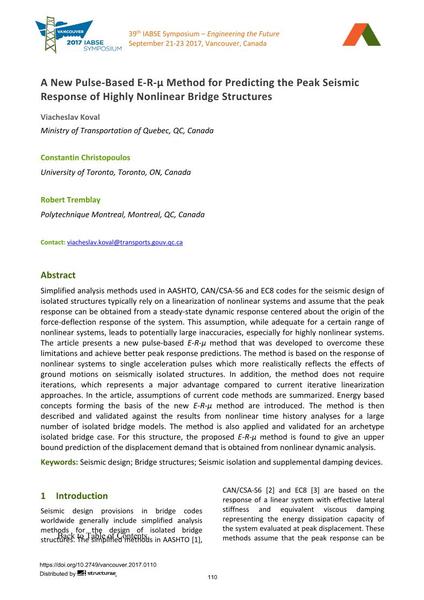A New Pulse-Based E-R-µ Method for Predicting the Peak Seismic Response of Highly Nonlinear Bridge Structures

|
|
|||||||||||
Détails bibliographiques
| Auteur(s): |
Viacheslav Koval
(Ministry of Transportation of Quebec, QC, Canada)
Constantin Christopoulos (University of Toronto, Toronto, ON, Canada) Robert Tremblay (Polytechnique Montreal, Montreal, QC, Canada) |
||||
|---|---|---|---|---|---|
| Médium: | papier de conférence | ||||
| Langue(s): | anglais | ||||
| Conférence: | IABSE Symposium: Engineering the Future, Vancouver, Canada, 21-23 September 2017 | ||||
| Publié dans: | IABSE Symposium Vancouver 2017 | ||||
|
|||||
| Page(s): | 110-119 | ||||
| Nombre total de pages (du PDF): | 10 | ||||
| Année: | 2017 | ||||
| DOI: | 10.2749/vancouver.2017.0110 | ||||
| Abstrait: |
Simplified analysis methods used in AASHTO, CAN/CSA-S6 and EC8 codes for the seismic design of isolated structures typically rely on a linearization of nonlinear systems and assume that the peak response can be obtained from a steady-state dynamic response centered about the origin of the force-deflection response of the system. This assumption, while adequate for a certain range of nonlinear systems, leads to potentially large inaccuracies, especially for highly nonlinear systems. The article presents a new pulse-basedE-R-µmethod that was developed to overcome these limitations and achieve better peak response predictions. The method is based on the response of nonlinear systems to single acceleration pulses which more realistically reflects the effects of ground motions on seismically isolated structures. In addition, the method does not require iterations, which represents a major advantage compared to current iterative linearization approaches. In the article, assumptions of current code methods are summarized. Energy based concepts forming the basis of the newE-R-µmethod are introduced. The method is then described and validated against the results from nonlinear time history analyses for a large number of isolated bridge models. The method is also applied and validated for an archetype isolated bridge case. For this structure, the proposedE-R-µmethod is found to give an upper bound prediction of the displacement demand that is obtained from nonlinear dynamic analysis. |
||||
| Mots-clé: |
conception sismique
|
||||
